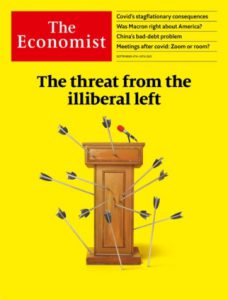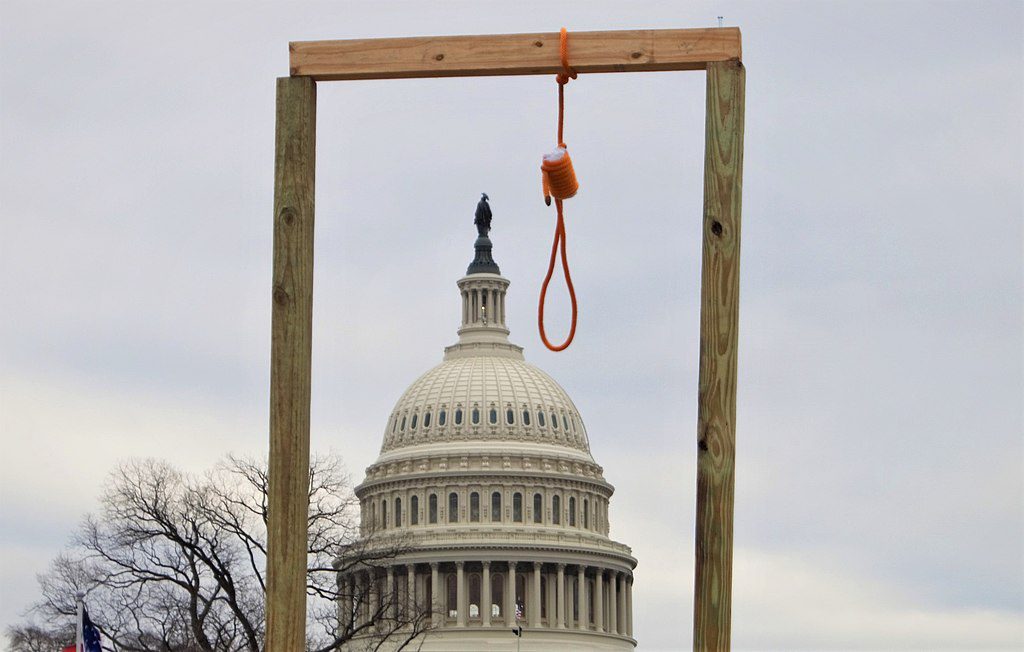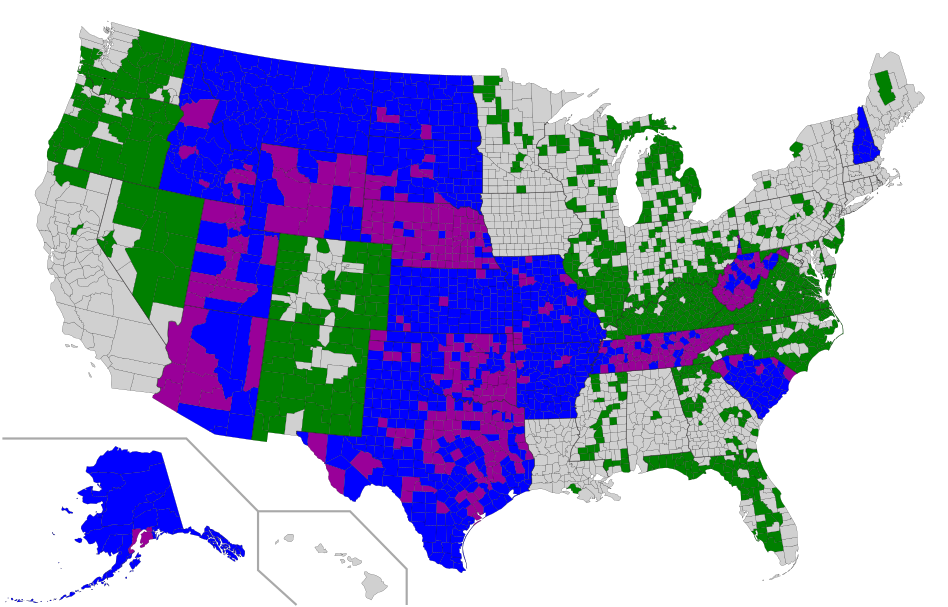“When our public square is governed by mob dynamics unrestrained by due process, we don’t get justice and inclusion; we get a society that ignores context, proportionality, mercy, and truth.” — Journalist Jonathan Haidt Describing Left- and Right-Wing Social Media, 2022
Liberalism Challenged From the Right & Left
QAnon
January 6
Guns
Optional Reading & Viewing
The GOP Debates Democracy
In 2020-21, the U.S. experienced its first domestic challenge to small-d democracy since the Civil War era (1849-77), but that story is ongoing as it’s still unclear how committed Americans are to their current constitutional framework. Scroll down to the bottom half of this 2021 GWU Poll but be wary of ambiguously-worded questions. The fundamental question is whether Americans want a system that includes the potential for the opposition to win elections, specifically whether or not Republicans are willing to abide by a system that includes the potential for Democrats to win elections. Most do, but a sizable minority don’t. But legal scholars warned that, since states control their elections and presidential electors per the Constitution (Article I, Section 2, Clause 2), Republican legislatures could legally overturn the will of the voters if they can find even the smallest infraction at any polling station or in any part of the multi-layered process; and that, in any event, there was a loophole in the 1887 Electoral Count Act and/or the Constitution itself allowing for electors to cast their ballot for losers in their home state. There have been 167 “faithless electors” in American history that have purposely cast ballots for the wrong person, including ten in 2016, but they’ve never overturned the proper result. Such a scenario could’ve overturned every winner in every state for every election we’ve ever had, including all the states Trump won in 2016. Yet, a similar scenario was the basis for Trump lawyer John Eastman’s plan, that Trump’s VP Mike Pence rejected on January 6, 2021 by carrying out the heretofore ceremonial congressional certification of election results. In 2022, Congress reached a bipartisan agreement to improve the 1887 Electoral Count Act and clarify the ambiguities of the Twelfth Amendment, so that electors have to vote for the real winners (winner-take-all in 48 states, proportionally in Maine and Nebraska). Still, as of 2022, a significant minority of conservatives, around 33%, favored civil war unless they got their way and Trump was unwilling to operate in a system that allowed for the possibility of losing elections, saying in both the 2016 and 2020 elections that he would only accept victorious results.
One faction on the far right endorses moving toward a more authoritarian model popularized by Hungarian Viktor Orbán, whose Fidesz party has, according to the European Union, used the country’s revised 2011 constitution to take over huge swaths of media (including those responsible for calling elections) and to subvert the customary separation of powers between the executive and judicial (courts) branches common in the West, albeit with methods similar to FDR’s unrealized court-packing scheme by forcing judges into early retirement so that he could replace them with supporters. Orbán also redrew electoral boundaries in the manner of American gerrymandering to favor himself. Fox journalist Tucker Carlson hitched his star to Orbán’s wagon in August 2021 by broadcasting from Budapest and rectifying his image (Fox News). Carlson wasn’t necessarily saying that the U.S. should adopt the Hungarian model, but wanted to at least recast Orbán’s image in the West, with special attention paid to his stricter immigration policy. In May 2022, the influential American CPAC (Conservative Political Action Conference) held a meeting in Budapest to underscore their endorsement of Orbán’s model, and Orban spoke at their American conference. Orban believes that unity is impossible in mixed-race societies, calling countries like the United States conglomerations of people rather than nations (The Hill). Hungary has also quasi-endorsed Christianity as its state religion, though not officially. Orbán asserts that he saved Hungary by turning it into an “illiberal democracy.” Orbán did indeed come to power through democratic elections — and he might still enjoy the support of a majority — but he’s also used that power to dismantle both a genuine modern democracy (robust on civil rights) and the small-r republican model America’s founders envisioned with its separation of powers. Orbán had lost a genuine election back in the 1990s and wasn’t about to make the same mistake. Like Vladimir Putin in Russia, he won’t have to worry about losing future “elections.” One potential American version, which would steer more power to the executive branch and dismantle the “administrative state,” can be found in Project 2025. Trump also threatened to retaliate against media like NBC that was critical of him if he was elected in 2024.
For conservative activist Christopher Rufo, one advantage of the Hungarian system over the American is that it gives the government more direct control over school curricula. He wrote “that the real reason so many left-liberals hate Hungary with such fervor is that the government has adopted their premise that the state has an abiding interest in managing and shaping society and used it to oppose goals opposed to theirs.” Both sides, in other words, favor indoctrination in schools rather than the promotion of free thought; but in Hungary’s case the government is imposing conservative ideology in schools, just as started to in Florida and Ohio in the early 21st century.
 Carlson also empathized with gender relations under the Taliban compared to the West, but didn’t go as far in support of their governing style as Congressman Matt Gaetz (R-FL) who, after Afghanistan’s Taliban took over Kabul in 2021, Tweeted® that their regime was more legitimate than America’s under Joe Biden (NYT). Gaetz may have been trolling for attention but, still, no Taliban supporter would’ve held or even been able to run for elected office in the U.S. twenty years earlier, after 9/11. In the unlikely event that America tweaks its constitution in an authoritarian direction (i.e. like Hungary’s or Russia’s), it would still retain the United States brand name and even be cloaked thicker than ever in patriotic symbols like flags and anthems; it would just jettison democracy as a component of America’s system and identity, except in its propaganda. The transition would come through executive orders rather than the amendment process and be sold with a promise to defend America’s constitution, not change it. Without doing anything too dramatic, the key would be to lock in one-party minority rule. An interesting exercise is to ask yourself what sort of constitution you’d like to live under when people you disagree with have power. It’s safe to say that, when CPAC endorsed the Hungarian model, they weren’t envisioning Democrats in power. During Trump’s presidency, democratically-elected leaders in Hungary, Turkey (Recep Tayyip Erdoğan), India (Narendra Modi), and the Philippines (Rodrigo Duterte) had taken advantage of their elections and popularity to consolidate more authoritarian rule, similar to Putin’s in post-Soviet Russia. Subconsciously at least, Trump may have come to envy and respect them more by 2020 than he savored America’s long bipartisan tradition of conceding elections, that he associated with losers and that he either didn’t realize democracy hinges on or just didn’t care anyway if he didn’t win. In 2016, he’d signaled that he wouldn’t accept defeat against Hillary Clinton, whom he often lurked behind during debates and suggested that he would imprison (the same way pro-Putin Victor Yanukovych had pro-American/NATO/EU Yulia Tymoshenko in Ukraine. Tymoshenko served three years in prison, as we read about in Chapter 22). Most of Trump’s followers ca. 2022 didn’t necessarily favor a Hungarian or Russian system outright over the U.S. Constitution, though; they just thought that Democrats wouldn’t be able to win elections in the American system if it was working properly. When Republicans audited the 2020 presidential election in Arizona, many were genuinely surprised that Joe Biden won their own recount, indicating a problem with filtering information rather than a desire for actual revolution. But, by 2023, right-wing think-tanks like Hillsdale College and the Claremont Institute started advocating “Red Caesarism” more openly, referring to Julius Caesar’s overthrow of Rome’s Republic in 49 B.C.E., signaling that they’d be on board with at least temporarily suspending American democracy.
Carlson also empathized with gender relations under the Taliban compared to the West, but didn’t go as far in support of their governing style as Congressman Matt Gaetz (R-FL) who, after Afghanistan’s Taliban took over Kabul in 2021, Tweeted® that their regime was more legitimate than America’s under Joe Biden (NYT). Gaetz may have been trolling for attention but, still, no Taliban supporter would’ve held or even been able to run for elected office in the U.S. twenty years earlier, after 9/11. In the unlikely event that America tweaks its constitution in an authoritarian direction (i.e. like Hungary’s or Russia’s), it would still retain the United States brand name and even be cloaked thicker than ever in patriotic symbols like flags and anthems; it would just jettison democracy as a component of America’s system and identity, except in its propaganda. The transition would come through executive orders rather than the amendment process and be sold with a promise to defend America’s constitution, not change it. Without doing anything too dramatic, the key would be to lock in one-party minority rule. An interesting exercise is to ask yourself what sort of constitution you’d like to live under when people you disagree with have power. It’s safe to say that, when CPAC endorsed the Hungarian model, they weren’t envisioning Democrats in power. During Trump’s presidency, democratically-elected leaders in Hungary, Turkey (Recep Tayyip Erdoğan), India (Narendra Modi), and the Philippines (Rodrigo Duterte) had taken advantage of their elections and popularity to consolidate more authoritarian rule, similar to Putin’s in post-Soviet Russia. Subconsciously at least, Trump may have come to envy and respect them more by 2020 than he savored America’s long bipartisan tradition of conceding elections, that he associated with losers and that he either didn’t realize democracy hinges on or just didn’t care anyway if he didn’t win. In 2016, he’d signaled that he wouldn’t accept defeat against Hillary Clinton, whom he often lurked behind during debates and suggested that he would imprison (the same way pro-Putin Victor Yanukovych had pro-American/NATO/EU Yulia Tymoshenko in Ukraine. Tymoshenko served three years in prison, as we read about in Chapter 22). Most of Trump’s followers ca. 2022 didn’t necessarily favor a Hungarian or Russian system outright over the U.S. Constitution, though; they just thought that Democrats wouldn’t be able to win elections in the American system if it was working properly. When Republicans audited the 2020 presidential election in Arizona, many were genuinely surprised that Joe Biden won their own recount, indicating a problem with filtering information rather than a desire for actual revolution. But, by 2023, right-wing think-tanks like Hillsdale College and the Claremont Institute started advocating “Red Caesarism” more openly, referring to Julius Caesar’s overthrow of Rome’s Republic in 49 B.C.E., signaling that they’d be on board with at least temporarily suspending American democracy.
On the other hand, once Trump bullied much of the GOP into endorsing the January 6th insurrection, several candidates ran in the Fall 2022 elections on platforms opposed to, or at least in favor of weakening, democracy. Rachel Hamm ran for California’s Secretary of State on the Republican ticket saying “I want to make it hard [to vote]” while Mike Lee (R-UT) said “we’re not a democracy. Democracy isn’t the objective; liberty, peace, and prosperity are. We want the human condition to flourish. Rank democracy can thwart that.” In Washington state, congressional Republican candidate Loren Culp called democracy “mob rule.” But, while it’s true that America’s Founders deliberately set up a representative democracy instead of a pure democracy — à la ancient Athens, Greece, more similar to today’s referendums and propositions with no politicians — and considered pure democracy “mob rule,” they didn’t mean that, within that representative system, we should award election victories to losers that wouldn’t accept defeat or endorsed authoritarianism. Joe Biden didn’t win because we have Athenian democracy; he won within the system of representative democracy that has gradually expanded suffrage in subsequent centuries. That expanded suffrage is presumably the the shifting baseline that Hamm, Lee, and Culp opposed.  At the 2024 CPAC convention, Joe Posobiec (right) promised to a cheering audience that, if Trump won, democracy would be dead. Later, he backpedaled, saying that he was just channeling Joe Biden sarcastically, though that didn’t make sense given that he said they’d finish what they started on January 6th. He then muddied the waters by saying that they would just destroy democracy temporarily, presumably long enough to get rid of any opposition (Yahoo). Wherever you come down on this issue, you should be aware that this is radical and new for one of the major parties to flirt with destroying democracy. As recently as 2020, nearly all Americans agreed that dictatorships were bad and associated American identity and patriotism with democracy.
At the 2024 CPAC convention, Joe Posobiec (right) promised to a cheering audience that, if Trump won, democracy would be dead. Later, he backpedaled, saying that he was just channeling Joe Biden sarcastically, though that didn’t make sense given that he said they’d finish what they started on January 6th. He then muddied the waters by saying that they would just destroy democracy temporarily, presumably long enough to get rid of any opposition (Yahoo). Wherever you come down on this issue, you should be aware that this is radical and new for one of the major parties to flirt with destroying democracy. As recently as 2020, nearly all Americans agreed that dictatorships were bad and associated American identity and patriotism with democracy.
But the GOP is divided on this issue because many Republicans continue to back democracy and still associate it with American identity as much as ever. Also, Vladimir Putin’s invasion of Ukraine into 2022 threw a monkey wrench into the American far-right’s infatuation with authoritarianism. In the run-up to the invasion, Trump, Carlson, Rudy Giuliani and other commentators on FOX initially sided with Putin, or at least praised him, maybe assuming that the rest of the GOP would follow. Instead, the subsequent barbarity of the Ukrainian war awakened many mainstream Republicans to their appreciation of democracy in the big scheme of things, and they fell in behind western-leaning Ukraine. Orbán also broke with Putin over Ukraine, partly because Hungary is in the North Atlantic Treaty Organization (NATO, Chaps 13 & 22) designed to fend off Russian aggression, but then he eventually hopped up on the fence as neutral on the war. Hoping to further divide the West, At first, it seemed that Putin may have accidentally re-awakened its inner-NATO and threatened to saw off his sympathizers in the quasi-authoritarian branch of the American tree. Trump and Carlson switched sides for awhile once they read the public’s mood, but the cat was out of the bag. Even a month into the war, with Putin’s American approval rating hovering ~ 4%, Trump showed his true commitment to domestic partisanship above western democracy by encouraging Putin to dig up dirt on Joe Biden’s son, Hunter. However, by 2024, many American conservatives had swung over to Putin’s camp, and the Trump made sure that the House GOP stalled aid to Ukraine, granting Russia critical assistance on the battlefield that turned the tide of the war. OAN promoted Putin’s theory that the hospital bombing in Mariupol, Ukraine was a hoax, and Tucker Carlson started promoting Russia as having a superior country to the U.S., or that we should at least be open to the idea. In early 2024, he gave an extended interview to Putin without challenging him fundamentally on anything important, including Putin’s assertion that Poland started World War II. Democrats saw authoritarianism for what it really was and remembered that, with Putin’s support, Trump tried to frame and extort Ukraine’s president Volodymyr Zelenskyy in 2019, leading to Trump’s first impeachment (Chapter 22). As America entered the 2024 election, it was unclear whether American voters favored Ukraine or Russia in their war, with Putin praying for a Trump victory.
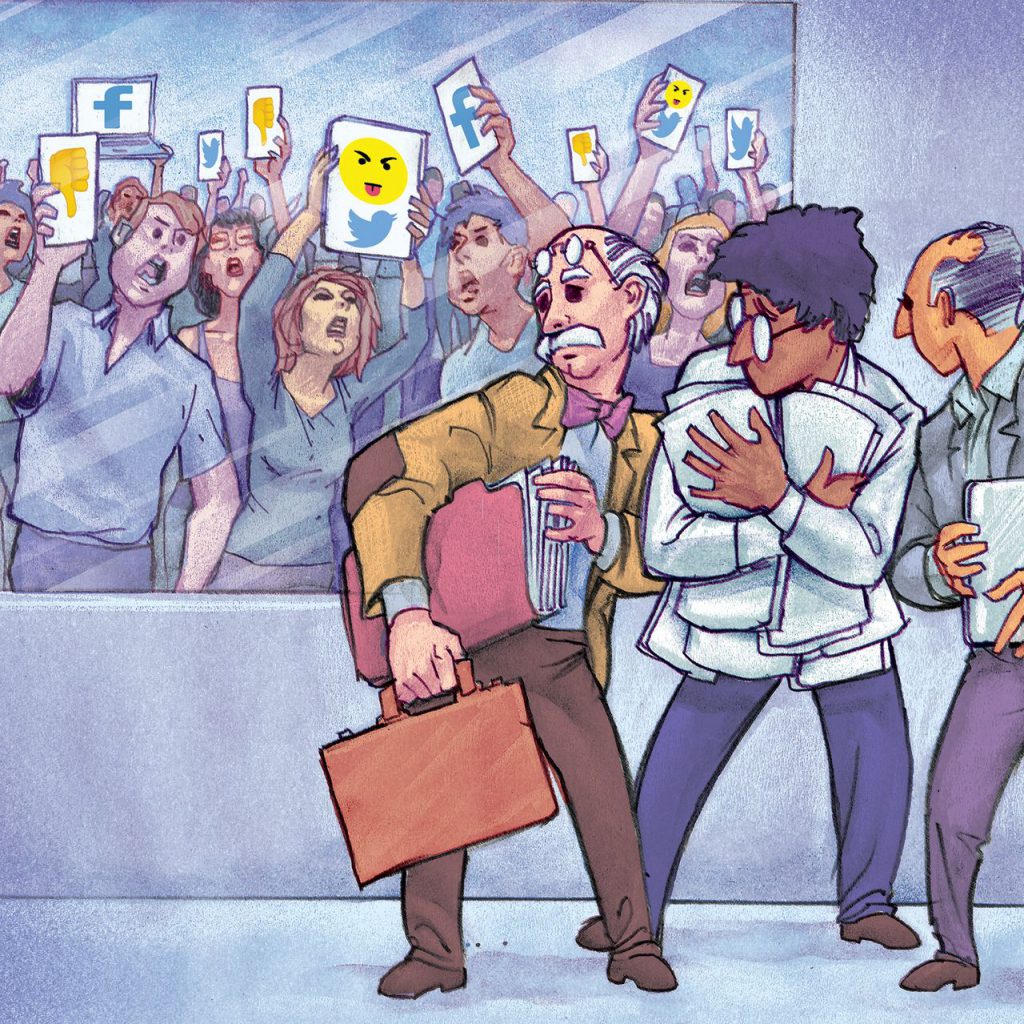 Cancel Culture
Cancel Culture
Some elements of the left also challenged longstanding liberal ideals, even though, politically, Democrats had no motive to challenge small-d democracy — partly because, like all Republicans from 1854-2016 and many still, they believed in and supported representative democracy as America’s chosen political system, even if that fruit was poisoned at the tree by its imperfect, slaveholding DWM founders. Demographic trends also seemingly favored Democratic voters. Such trends rarely play out the way we expect but, if anything, it was in the left’s interests to bolster democracy by shedding the electoral college and partisan gerrymandering and granting full representation to U.S. territories and the District of Columbia (D.C.). Those same demographic trends toward younger and more liberal likewise explain a recent shift left in corporate public relations, if not actions. But early 21st-century progressives, in earnest if draconian, prudish, sanctimonious, and presumptuous attempts to improve and enlighten the world, used their soft power in academics and media/entertainment to call out (shame), silence, and deplatform those they disagreed with instead of engaging or challenging them to open debate in the liberal tradition. Ancient Greeks considered this form of ostracism the next-worst punishment behind the death penalty. Woke progressives relished playing Whac-a-Mole™ with heretics to maintain purity within their hive mind. Like McCarthyites during the Red Scare, the goal was to purge society of those that disagree, and victims could be guilty by association with someone else that’s imperfect. Thus, for instance, the the modern Sierra Club’s need to distance itself from its founder John Muir because, while he admirably pioneered conservation and environmentalism, he had a mixed record on race, not coming around to modern progressive views until later in life (National Review).
Right-wing media made hay from the unpopularity of thought-controlling cancel culture but then co-opted for themselves either to “fight fire with fire” or, more likely, because it was a function of technology as much as principle: the logic of social media algorithms made it effective even if ultimately counter-productive. Media on the left were divided on the severity of the problem. Critics bemoaned how being easily offended became a marker of political awareness (mere virtue signaling), distracting social justice warriors from more substantive activism, while cancel culture’s supporters argued that it was just a natural extension of arguments over political correctness from the 1980s and ’90s or shrugged off its victims as the price of progress. On the upside, cancel culture was a non-violent way to hold people to account, call out injustice and, recognizing the power of language, break down ingrained systems of prejudice and exploitation, especially for historically marginalized groups. The New York Times’ Michelle Goldberg argued in this op-ed that near-left stalwarts like Atlantic and Economist were hyperbolic in their criticism of the illiberal left, relying on anecdotal evidence and inspired by a liberal version of the cranky, middle-age white male, though neither the victims nor critics (e.g., Barack Obama, Anne Applebaum) of cancel culture were exclusively white males and some of its advocates were. Instead, such movements often feed on themselves. In Chapter 20 we suggested that, rather than Re-Tweeting being like handing a four-year-old a loaded weapon as its inventor lamented, it really provided darts. Many of these darts are used within bubbles on the left and right, making sure that any potential dissenters hew to orthodoxy and don’t dare to think independently. In 2020, a diverse group of artists, writers, and scholars signed a petition published in left-leaning Harper’s, “A Letter On Justice & Open Debate,” denouncing this climate of intolerance and igniting an intra-liberal firestorm (NYT). Cancel culture turned Harry Potter actor Daniel Radcliffe against series author J.K. Dowling when Dowling made purportedly transphobic remarks (Wiki). By 2022, major companies and institutions had to unnecessarily weigh in and take stands on political issues, which was a clear recipe for more divisiveness but good for the thriving culture war trade. To apply for many colleges, applicants had to satisfactorily explain not just their opposition to racism, but active contributions to reducing it. That’s a pretty specific demand for the general population at a public institution, even if almost everyone would agree that racism is bad.
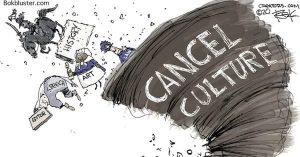 Terms like cancel culture, political correctness, and woke evolve and start being applied in broader contexts than their original use, especially once the public gets a whiff of their unpopularity. For instance, football player Aaron Rodgers said that not getting vaxxed put him in the “crosshairs of a woke mob” even though woke, which dates back to the 1930s in African-American culture and is now broadly tied to identity politics, doesn’t really have anything to do with medicine, employee rights, or government power; it is not an antonym for libertarian. He did fall victim to Twitterati but, rather than getting “cancelled,” Rogers just got COVID followed by an old-fashioned one-game suspension from his employer. Likewise, politically correct originally referred to progressive but nitpicky, or something factually correct that one wouldn’t say in public or polite company. Later it became a modern synonym for euphemism, expanded to include corporate speak/public relations, and was used to shield things more clearly out of mainstream bounds, as in “I just joined the Ku Klux Klan. I know that’s not p.c.” When three men were convicted of murdering Ahmaud Arbery in 2021, their defense attorney blamed the jury’s verdict on a “leftist woke mob” rather than the more straightforward explanation that they did it and filmed their own crime.
Terms like cancel culture, political correctness, and woke evolve and start being applied in broader contexts than their original use, especially once the public gets a whiff of their unpopularity. For instance, football player Aaron Rodgers said that not getting vaxxed put him in the “crosshairs of a woke mob” even though woke, which dates back to the 1930s in African-American culture and is now broadly tied to identity politics, doesn’t really have anything to do with medicine, employee rights, or government power; it is not an antonym for libertarian. He did fall victim to Twitterati but, rather than getting “cancelled,” Rogers just got COVID followed by an old-fashioned one-game suspension from his employer. Likewise, politically correct originally referred to progressive but nitpicky, or something factually correct that one wouldn’t say in public or polite company. Later it became a modern synonym for euphemism, expanded to include corporate speak/public relations, and was used to shield things more clearly out of mainstream bounds, as in “I just joined the Ku Klux Klan. I know that’s not p.c.” When three men were convicted of murdering Ahmaud Arbery in 2021, their defense attorney blamed the jury’s verdict on a “leftist woke mob” rather than the more straightforward explanation that they did it and filmed their own crime.
The Economist, meanwhile, described simultaneous threats to the liberal tradition from the right and left as asymmetrical: “[conservative] populists denigrate [liberal traditions like] science and the rule of law as facades for a plot by the deep state against the people. They subordinate facts and reason to tribal emotion….[the illiberal left] have brought along tactics [from universities to the workplace and media] to enforce ideological purity, by no-platforming their enemies and cancelling allies who have transgressed — with echoes of the confessional state that dominated Europe before classical liberalism took root at the end of the 18th century…classical liberals conceded that your freedom to swing your fist stops where my nose begins. Today’s progressives argue that your freedom to express your opinions stops where my feelings begin.” The new premium on fragility as a virtue was new to liberalism. Liberals didn’t oppose McCarthyism in the 1950s because they hoped to replace it later with left-wing witch-hunts, goes this line of thinking. Author Ray Bradbury wrote in Fahrenheit 451 (1953): “There is more than one way to burn a book. And the world is full of people with running about with lit matches.” Whereas old-school liberals fought for free-speech zones, 21st-century “eggshell plaintiffs” advocated for “safe zones” that restricted free speech to inoculate against micro-transgressions. Corporations followed suit, with companies like Coca-Cola holding inclusion workshops on how to act “less white” (often awkwardly including non-Whites in the audience). The term Great Awokening, as in Great Awakening, underscored the religious dimensions of this secular movement. The problem with anti-racist catechisms on college applications isn’t anti-racism (that’s great); it’s that catechisms are, by definition, doctrinal and hostile to independent thought. Groupthink conformity is evidently our natural default state but, if the modern left has abandoned tolerant liberalism and reverted to catechisms, heresies, online inquisitions, and excommunication (ostracism), they’ve at least replaced medieval Christianity’s physical torture with derailing the careers and reputations of those who challenge narrowly-defined and rapidly evolving tribal orthodoxy. Unfortunately, we’ve also replaced Christian notions of redemption, mercy, and forgiveness with frantic, sanctimonious inquiries into whether a person is not only perfect but always has been. No sin can be redeemed. So, for instance, when actor Matt Damon confessed to having used a derogatory term for homosexuals when he was younger and explained how he learned from his daughter why that was wrong, it wasn’t good enough. This petty mercilessness results from a contest among friends over who is most woke as measured by being most against the derogatory term, sometimes pejoratively called virtue signaling. To show Damon mercy would subject the insufficiently offended person to their own ostracism from the rest for lack of commitment to the cause. But before we single out today’s signalers, we should remember that virtue signaling of various forms has undoubtedly been around since the dawn of time and may play an important ethical/historical function. Likewise, while the religious analogy with the illiberal left has negative connotations, remember that modern progressive politics is rooted in the social justice and gospel movements of 19th-century Christianity, both Catholic and Protestant.
Technology was at the heart of these changes, just as it was with misunderstanding leading to the January 6 insurrection described below. Ostracism is as old as civilization itself, but social media enabled small groups of people to exert pressure disproportionate to their numbers. Regardless of whether online mobs attacked from the left or right, defendants weren’t afforded due process of law, presumption of innocence, statute of limitations, or the right to defend themselves except to profusely apologize for offenses real or imagined, creating an informal court of public opinion more illiberal in some fundamental ways than the real justice system, which retained plenty of its own problems. Right and left both restricted speech within “rhetorical fortresses:” on the right, any idea could be dismissed out of hand if uttered by an “expert” or mainstream media; on the left opinions could be dismissed by ad hominem attacks on someone’s identity, namely being white, heterosexual, or male. But there were many people across the political spectrum in the early 21st century, including some that used the tactics described above, that were focused on substantive issues — more so than their parents’ generation because they were living through more dramatic history.

Ron Watkins who, along with his father Jim, hosted Q on 8Chan. A 2021 HBO documentary argued that one of the Watkins (or both) was Q.
QAnon
In the late 2010s, QAnon synthesized, wove together, and updated other conspiracy theories, topped off by suspicion among some followers that leading Democrats and liberals like actor Tom Hanks and CNN’s Anderson Cooper, along with journalists and moderate Republicans, were part of a Jewish-funded, devil-worshiping cabal of cannibalistic, sex-trafficking pedophiles. Q, likely Ron Watkins (right) and/or his father Jim, posted anonymous “Q-drops” on the 8chan message board. Its popularity forced the Republican Party into a tenuous quasi-alliance whereby it distanced itself from QAnon publicly while courting its followers. In August 2020, the Texas GOP coincidentally adopted “we are the storm” as its slogan, claiming inspiration from Psalm 29 and no connection to Q’s “storm” prophesy of Trump arresting the secret cabal — poor timing and marketing if they hoped to distance themselves. Trump claimed he didn’t know anything about the group except that they opposed pedophilia and he agreed (who wouldn’t?). Ironically, 8chan itself had briefly hosted child pornography.
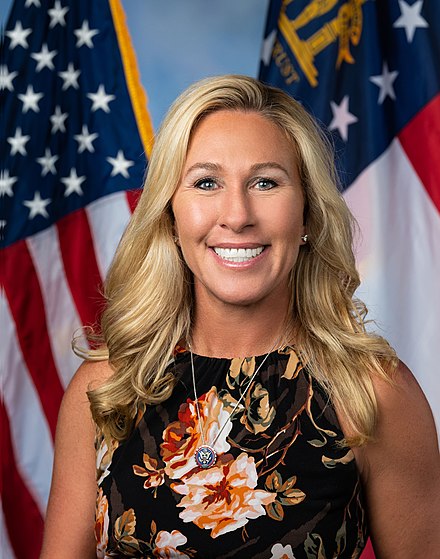 In 2020, five QAnoners ran on Republican congressional tickets with two winning seats in the House of Representatives, leading some comedians to call the GOP the GQP. More ran in 2022, though they didn’t do well. In 2018, future Congresswoman Marjorie Taylor Greene (R-GA) began promoting the QAnon conspiracies, topped off with their “Frazzledrip” theory, a Pizzagate offshoot, that Hillary Clinton murdered a child and sucked her blood during a Satanic ritual. She suggested that California governor Jerry Brown (D), the utilities, and Rothschild investment firm started forest fires with space lasers, leading Senate Minority Leader Mitch McConnell (R-KY) to call Greene a “cancer for the Republican Party” when she started her term in 2021. Rothschild was a frequent antisemitic target. Greene got her toehold in national politics by accosting a fellow student of the Parkland shooting victims, claiming that they’d made it up to spur gun regulations. She likewise called the Las Vegas mass shooting of 2017 a false flag operation. Without her outrageous inhumanity, she wouldn’t have gained enough traction on social media to launch a political career. Instead, she ended up serving in the House of Representatives after running in a remote rural district instead of her native Atlanta suburb. Establishment GOP denounced her, initially denying her committee assignments, but MTG raised more campaign donations than other Republicans, including even senators, so they had to yield to her influence and popularity.
In 2020, five QAnoners ran on Republican congressional tickets with two winning seats in the House of Representatives, leading some comedians to call the GOP the GQP. More ran in 2022, though they didn’t do well. In 2018, future Congresswoman Marjorie Taylor Greene (R-GA) began promoting the QAnon conspiracies, topped off with their “Frazzledrip” theory, a Pizzagate offshoot, that Hillary Clinton murdered a child and sucked her blood during a Satanic ritual. She suggested that California governor Jerry Brown (D), the utilities, and Rothschild investment firm started forest fires with space lasers, leading Senate Minority Leader Mitch McConnell (R-KY) to call Greene a “cancer for the Republican Party” when she started her term in 2021. Rothschild was a frequent antisemitic target. Greene got her toehold in national politics by accosting a fellow student of the Parkland shooting victims, claiming that they’d made it up to spur gun regulations. She likewise called the Las Vegas mass shooting of 2017 a false flag operation. Without her outrageous inhumanity, she wouldn’t have gained enough traction on social media to launch a political career. Instead, she ended up serving in the House of Representatives after running in a remote rural district instead of her native Atlanta suburb. Establishment GOP denounced her, initially denying her committee assignments, but MTG raised more campaign donations than other Republicans, including even senators, so they had to yield to her influence and popularity.
QAnon’s popularity and context transcended the media deregulation we discussed in Chapter 20. Conspiracy theories are as old as politics itself and offer people a way to seemingly make sense of a complicated word. While, in this case, its audience was on the far-right, adherents’ real trust isn’t in one party or the other so much as the producer/director of the fantasy world they’re inhabiting. Reality has become to boring to pay attention to. QAnon, with its “where we go one, we go all” slogan, offered allegiance to a patriotic group identity. The slogan’s #WWG1WGA hashtag and OK hand gesture had the appeal of insider knowledge, like a secret handshake except one that sympathetic politicians and military leaders could signal in selfies. Trump began closing his rallies with a song similar to the WWG1 theme.
Had QAnon been on a menu, it would’ve offered “everything but the kitchen sink.” While QAnon traced most unoriginally to centuries of anti-Semitic tropes (e.g. Protocols of the Elders of Zion, blood libel, etc.), it also drew on the Satanic Panic of earlier eras and the 1980s and ’90s, when Americans transitioned uneasily away from single-income nuclear families and some falsely suspected daycares of ritualistic pedophilia (e.g., McMartin Pre-School trial). Q’s anonymity also offered intrigue reminiscent of Watergate’s Deep Throat (Chapter 19). Religiously, the QAnon world was cleanly divided between good and evil. Its Great Awakening phrase borrowed directly from 18th and 19th-century American Protestantism and dovetailed with apocalyptic faiths like those associated with the New Apostolic Reformation that saw Trump as God’s chosen president to fight the forces of evil. Historically, QAnon was rooted firmly in the longstanding “paranoid style” Richard Hofstadter described in Chapter 16, similar but more outrageous than the Birchers that formed in 1958. Intellectually, QAnon’s foundation was the idea that nothing is random. Whereas boring “normies” like your professors value evidence, are open to random coincidences, believe power is dispersed among competing factions rather than a single, secretive cabal, have eaten too many “blue pills” (above, making them content in their ignorance), and are generally blind to what’s really going on, those in the know abandon skepticism and evidence altogether and connect every dot in sight. The result is simultaneously tidier, more fantastic, and easier to digest than the unsettling mess called reality you’ve been subjected to in previous chapters.
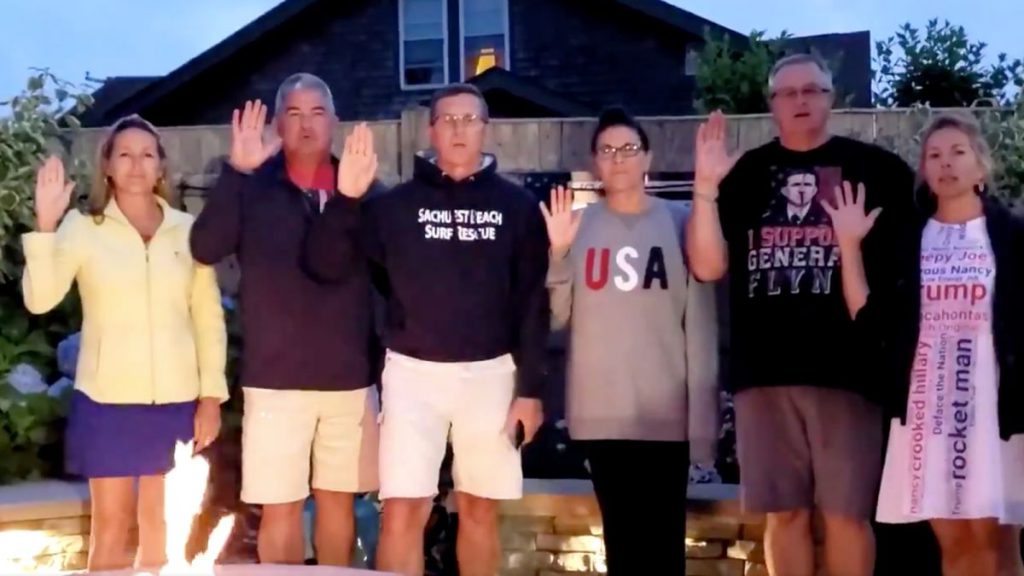
Lt. General Michael Flynn (3rd from left) Pledging Allegiance to QAnon, July 2020. When Asked Under Oath If He Supported Peaceful Transitions of Power During The January 6 Hearings In June 2022, Flynn Took The Fifth (Exercised His Right To Not Incriminate Himself). Flynn Encouraged Trump To Use The Military To Seize Voting Machines In Swing States After The 2020 Election.
It’s easy for anyone to go down compelling Internet rabbit holes and was especially so during the COVID-19 lockdown, with less normal social interactions. QAnoners could enjoy the learning curve the way one might with a hobby or game like Dungeons & Dragons®. Q’s brilliance was to cynically take advantage of historically low journalistic standards and peoples’ need to make simple sense of a complicated world. QAnoners like Ginni Thomas (below) fell in with militias and a hodgepodge of overly-enthusiastic Trump supporters in the January 6 Capitol Siege. By Fall 2022, Trump was openly allying himself with QAnon, “re-truthing” about the coming storm (his reinstatement as president) on Truth Social, and posting his own q-drops from a top-secret government official (AP).
By 2024, QAnon’s influence was starting to wane, but the mainstream acceptance of sketchy conspiracy theories wasn’t. Around 20% of Americans and 33% of Republicans believed that the NFL conspired with the government to rig the NFL playoffs so that the Kansas City Chiefs would win the 2024 Super Bowl, giving their tight end Travis Kelce’s girlfriend, pop star Taylor Swift, a better platform from which to promote Joe Biden’s presidential re-election. For many Americans, if it’s possible to conceive of any motive for something to happen, that means it is happening.
January 6: The New ‘Lost Cause’
First, some background on the general state of street violence in the USA ca. 2020. While January 6 was the most famous of many domestic showdowns in the early 21st century, and it included the Capitol police shooting Ashli Babbitt, it was somewhat of an outlier insofar as it didn’t involve guns and armed intimidation on the scale usually seen in the states. Law enforcement was initially outgunned by protesters in Nevada’s Cliven Bundy Standoff (4.14) and Charlottesville’s Unite the Right Rally (8.17) as citizens combined the Second Amendment right to bear arms with the First Amendment right to free speech and assembly, though in neither case did protesters open fire. Likewise, protesters In Dallas (2016), Kenosha (2020), and Portland (2020) were armed but those events didn’t escalate beyond a few deaths. Expansive interpretations of the Second Amendment combined with normal interpretations of the First Amendment rights to free speech and assembly appear on a collision course, especially in open carry states like Texas without special event restrictions. Media fragmentation compounds the volatility as the opponents in street confrontations don’t share an agreed-upon reality. If this trio of factors gets too combustible, the adults in the room will be hard-pressed to hold the center and keep the system functioning, despite the low numbers of Americans in fringe groups (thus their name).
The far left isn’t as militarized as the far right, but protesters took over six square blocks of Seattle’s Capitol Hill neighborhood for three weeks in 2020 (CHOP), enabled by lenient and misguided Democratic mayoral policy. America’s Antifa branch is the most high-profile leftist group but they’re decentralized, with no pull inside the Democratic Party since, as anarchists, they don’t vote and are further left on the economic spectrum than politicians. Antifa affiliates’ methods range from peaceful (marching, organizing) to obnoxious (doxxing, harassment, property damage) to violent (fighting, milkshaking, rock-tossing, occasional shootings), but most Americans agree with their opposition to racism and fascism (broadly and vaguely defined) if not their methods and desire to dismantle capitalism. But the Democratic Party set lenient policies in areas like the Pacific Northwest and Minneapolis, where protests included looting and burning, in the aftermath of George Floyd’s murder in 2020. That was, in turn, connected to right-wing vigilantism symbolized by Kyle Rittenhouse in Kenosha, Wisconsin.

Six Million Was Not Enough (in the Holocaust) T-Shirt Worn By Proud Boy Protesting Joe Biden’s Election Certification in Washington, D.C., 2021
On the far right, it won’t bode well if lines blur between their militias and law enforcement, as they did in Kenosha and (indirectly) Washington, D.C., or if politicians incite private militias as Trump did in Michigan to protest COVID restrictions and to protest Joe Biden’s election in the Capitol Siege with the Boogaloo Bois, Proud Boys, and Oath Keepers, Tweeting them on December 19, 2020 “Big Protest in D.C. on January 6th. Be there, will be wild!” He then told those assembled on January 6 that they “wouldn’t have a country anymore” if they didn’t “fight like hell” (AP). Appealing to his audience’s sense of privileged identity, Trump said “Our country has been under siege for a long time…You’re the real people. You’re the people that built this nation.” In his last debate with Biden, Trump had told the Proud Boys to “stand back and stand by.” The 1st Amendment Praetorion (1AP) guarded elite Trump supporters like Michael Flynn (NYT). Their members vary widely in their political views, ranging from weekend warriors playing army with their buddies all the way to hardcore neo-Nazis (right). The militias aren’t uniformly white, but many share Charles Manson’s sense of impending racial conflict (Chapter 16). Timothy McVeigh was a veteran of the First Gulf War bitter that he’d been denied entry into Special Forces. His bombing of the Murrow Federal Building in Oklahoma City in 1995, the biggest mass-murder in American history and the worst attack on American soil between Pearl Harbor (1941) and 9/11 (2001), was intended to incite a racial war whereby Whites would take back their country. McVeigh’s attack led to (or it least correlated with) increased membership in far-right groups. Others came out of the prison system, where racial gangs are an everyday necessity for survival, and fringe groups have infiltrated some prison security. The more serious variety of these groups thinks it’s their prerogative to impose their will on others with force rather than through democratic means like voting, debate, legislation, boycotts, and op-eds. Patriotic in the extreme, they have no faith in the American form of government except for how they wrongly imagine it to have been in 1776.
Washington, D.C. disallows even permitted concealed weapons near protests, which weakened the hand of those trying to overturn Joe Biden’s victory in the 2020 presidential election and/or lynch VP Mike Pence for certifying the electoral college results on January 6, 2021 on behalf of Trump’s attempt to “stop the steal” (other protestors argued instead for burning him to death “along with all the others”). But they still had various small weapons and Trump demanded that they not be disarmed with metal detectors before they heard his January 6th speech in the Ellipse behind the White House because they weren’t there to harm him. Evidently, he didn’t mind if they harmed others because he more or less proceeded to encourage them to do just that. Some demonstrators had burner phones to provide updates to the Trump administration. As the melee unfolded, FOX journalists, including Sean Hannity, texted the White House in a vain attempt to get Trump to call it off, fearing that it would mar his legacy. Hannity had texted Trump’s Chief of Staff Mark Meadows the day before, saying “I’m very worried about the next 48 hours.” Meadows, meanwhile, warned his assistant Cassidy Hutchinson on January 4th that things could get “real, real bad” on January 6th.
They did, but could’ve gotten much worse. After Trump rallied his followers at the Ellipse to go “fight like hell” — thus knowingly encouraging insurrection against the United States — the White House drug its feet deploying the National Guard, with Trump purportedly just watching on TV for nearly an hour-and-a-half (87 minutes) until the Pentagon finally gave up on him and called in the Guard themselves. When House GOP leader Kevin McCarthy (R-CA) called Trump begging him to call off his rioters, he said, “Well, Kevin, I guess these people are more upset about the election than you are.” Finally, Trump Tweeted a video to his minions, instructing them to “Go home. We love you; you’re very special. But go home and go home in peace.”
By then, even without guns, rioters had beaten, stomped, tased, and speared 140 police officers, causing traumatic brain injuries, crushed spinal discs, burns, eye damage, and one fatal heart attack/stroke. Four officers committed suicide within six months. They taunted African-American officer Harry Dunn with the N-word as they pounded him and spread their feces around the Capitol. This wasn’t Antifa or BLM throwing rocks at a federal courthouse in the provinces, but rather a direct attack on democracy’s beating heart. HBO’s Four Hours at the Capitol documentary showed how armed but outnumbered officers talked down some of the protesters and how some invaders were awed by the majesty of the Capitol they were vandalizing, especially the Rotunda and National Statuary Hall. One earnest young man, there to protest Democrats enslaving and eating babies, passed out joints to his comrades in the hallowed Statuary Hall.
If not for D.C.’s weapons restriction and the heroism of some Capitol Police and, earlier, Republican judges, politicians, and election officials in swing states who stood their ground and backed Uncle Sam amidst death threats and intense pressure — typified by Trump’s infamous call to Georgia Secretary of State Brad Raffensperger (hear portions below to 2:33) — the constitutional republic would’ve temporarily ceased functioning for the first time since its inception in 1789, with the executive branch overriding the legislative (the “first branch of government”) and a president remaining in power after losing re-election. There were still two weeks before Biden’s inauguration.
No real democracy could function with the losing presidential candidate seizing or, in this case, holding, power. Republicans in Michigan tried to alter (mostly Democratic) Detroit’s votes after Trump strong-armed them but it was too late, as they’d already signed off, initially assuming they were supposed to follow the law. Republican Aaron Van Langevelde stood up to Trump in Michigan, refusing to let that happen. In Arizona, Republican Governor Doug Ducey signed off on Biden’s win as Trump’s unanswered phone call buzzed incessantly in his pocket.
Rusty Bowers, speaker of Arizona’s state house of representatives and a die-hard Trump supporter in the 2016 and 2020 elections, was booted out of his state’s GOP for failing to support overturning the election in Trump’s favor. An armed “Trump Train” of pickups festooned with MAGA flags blasting their blowhorns, some with digital signs proclaiming him to be a pedophile, surrounded his ranch threatening him as his daughter lay inside dying from liver failure. Bowers said “the Constitution is hanging by a thread…the funny thing is I always thought it would be the other guys [Democrats]. That just rips at my heart: that we would be the people who would surrender the Constitution in order to win the election. That just blows my mind.” Bowers described the post-January 6th GOP as fascist and Trump’s loyalists as a “clown circus.”  Eighty of the 535 initially charged for January 6 were connected to extremist/paramilitary groups, with other participants drawn from QAnon and current or former local/state GOP officials (57), military (55), and police (12). Those not in fringe groups outnumbered those that were ~ 6:1. They didn’t skew white- or blue-collar and their ranks included doctors, architects, marketers, and a State Department official. As we’ve seen in previous U.S. wars, only a small, nearly immeasurable percentage of veterans transition to fringe groups, but those groups are so small to begin with that even a smidgen of veterans can bolster their numbers. In the War on Terror, those serving in Iraq and Afghanistan saw firsthand how fluid politics can be in terms of coups and revolutions, etc., which never occurs to most Americans because they’re living under the oldest major government on Earth with a long track record of stability. But the average age of these insurgents was just under 42, older than the 25-35 year-old range usually seen, globally, among those seeking real revolution. Ginni Thomas (right), the wife of Supreme Court justice Clarence Thomas, participated in the insurrection while Tweeting the White House 28 times promoting QAnon theories and about the need to imprison Joe Biden on a barge off Guantanamo. Clarence Thomas was then the lone judge to vote against requiring Trump to turn off his records for that day to the investigation committee (seven hours of phone records are still missing).
Eighty of the 535 initially charged for January 6 were connected to extremist/paramilitary groups, with other participants drawn from QAnon and current or former local/state GOP officials (57), military (55), and police (12). Those not in fringe groups outnumbered those that were ~ 6:1. They didn’t skew white- or blue-collar and their ranks included doctors, architects, marketers, and a State Department official. As we’ve seen in previous U.S. wars, only a small, nearly immeasurable percentage of veterans transition to fringe groups, but those groups are so small to begin with that even a smidgen of veterans can bolster their numbers. In the War on Terror, those serving in Iraq and Afghanistan saw firsthand how fluid politics can be in terms of coups and revolutions, etc., which never occurs to most Americans because they’re living under the oldest major government on Earth with a long track record of stability. But the average age of these insurgents was just under 42, older than the 25-35 year-old range usually seen, globally, among those seeking real revolution. Ginni Thomas (right), the wife of Supreme Court justice Clarence Thomas, participated in the insurrection while Tweeting the White House 28 times promoting QAnon theories and about the need to imprison Joe Biden on a barge off Guantanamo. Clarence Thomas was then the lone judge to vote against requiring Trump to turn off his records for that day to the investigation committee (seven hours of phone records are still missing).
Only an investigation will reveal how involved members of Congress were, but far-right activist Ali Alexander credited three, including Paul Gosar (R-AZ), saying that they “schemed up putting maximum pressure on Congress while they were voting.” Lauren Boebert (R-CO) Tweeted “Today is 1776” the morning of, while Josh Hawley (R-MO) saluted the crowd an hour before they stormed the gates (left), but sprinted out in fright a couple of hours later, leading Adam Kinzinger (R-IL) to label him “Fistpump McRunpants.” The night of January 5th, Trump’s former right-hand man, Steve Bannon, advised him to “kill [Biden’s] administration in the crib” and told his podcast audience that “all Hell is going to break loose” tomorrow. Representative Mo Brooks (R-AL), who later confessed to investigators that Trump told him to “illegally rescind Biden’s votes,” spoke before Trump, lambasting fellow Republicans who refused to overturn the election and saying, “Today is the day that American patriots start taking down names and kicking ass.”
Roger Stone, Michael Flynn, Rudy Giuliani, and Trump’s lawyer John Eastman gathered in a “command center” hotel room overlooking the Stop the Steal rally. Eastman lobbied VP Pence that he had the authority to throw out the electoral vote in states that Biden won. These states supposedly had a parallel track of alternate pro-Trump electors that the public didn’t know about, even if Biden won the popular vote in those states. They even sent fake electoral ballots from seven states to the National Archives, but the incorrect information and common templates tipped off their staff.
When Trump’s lawyer Eric Herschmann heard about this crackpot scheme he asked Eastman “are you out of your effing mind?” While testifying in the January 6 Attack Hearings in June 2022, Judge J. Michael Luttig, whom Eastman had clerked under, eviscerated him for trying to destroy the Constitution. Chapman College, where Eastman was Dean of Law, promptly fired him after the Eastman Memos came to light. Hoping to dupe Pence, Trump and Eastman at first told him that these alternate electoral changes had already happened, so he just needed to confirm them. George H.W. Bush’s former VP, Dan Quayle (R-IN), advised his friend Pence to reject the Eastman plot and he did, arguing that under Article II, Section 1 of the Constitution, the VP’s role in electoral certification was merely ceremonial. Joe Biden defeated Trump 306-232 in the electoral college, nearly the identical spread that Trump defeated Hillary Clinton by in 2016 (304-227), which Trump called a “massive landslide victory” (Clinton won the popular vote by just under three million).
Trump didn’t understand why Republican election officials would be so “disloyal” as to go along with declaring a Democrat the victor. In January 2022, perhaps choosing the wrong verbiage, Trump lamented that “[Pence] could have overturned the election!” As mentioned above, technically, the Constitution really might have a loophole on this issue, though it’s never been tested in the courts. Prior to 2020, all voters of every political party would’ve thought it was weird to award the presidency to the loser on those grounds.
Then there was the argument that Trump actually won anyway. In both elections that he ran in, Trump complained of millions of his votes being tossed in the trash even before the election started. But in the two months between the election and certification, Trump’s Justice Department, state legislators — including Republicans like Michigan’s Ed McBroom (right) in the optional Tim Alberta article below — and judges in SCOTUS and numerous lower courts distinguished between the quality and quantity of evidence for substantive voter fraud or rigged voting machines and refused to ban mail-in ballots ex-post facto. Tabulating such absentee ballots last had confused TV audiences because, in some states, Trump had an early lead that Biden closed days later. In GOP-controlled Pennsylvania, this was by design, likely to accentuate the effect known as the red mirage or, alternatively, blue shift. Fox even warned their viewers about it ahead of time because they knew it would happen and they knew that Trump would try to spin it as corrupt. Trump’s opposition to mail-in voting during COVID-19 inadvertently discouraged his own voters from trusting in the process, which might have cost him a close but clean election (one of the reasons for mail-in voting, usually, is that it benefits older voters, who skew Republican). In 2022, an October 2020 audio leaked of Trump strategist Steve Bannon planning how they would use the blue shift to trick their supporters into thinking that Trump won if he lost:
But Trump never mounted a serious argument that he’d actually won. Instead, echoing Wilmington’s 1898 Democratic insurrectionists — who saw themselves as agents of restoration, not revolution, because the Framers “did not anticipate the enfranchisement of an ignorant population of African origin,” Trump argued that Congress and VP Pence should overturn the 2020 election results because voters from places like “Detroit and Philadelphia…could not be responsible for engineering the outcome of a presidential race” (Atlantic).
Trump’s own top election official, Chris Krebs at the Cybersecurity & Infrastructure Security Agency, called 2020 the “most secure election in history” (AP), so Trump fired him. The Associated Press then did a year-long study of fraud claims in six contested states that Biden won and found only 475 possible cases out of tens of millions of voters — all unconnected and nowhere near enough to swing the election (AP). This conspiracy theory hinges heavily on its believers not seeing “the forest for the trees” (Rear Defogger #2 in tab above). While the quantity of evidence for Trump’s claim of fraud, cheating, or “millions of missing ballots” outside the courtroom was enormous and will grow in coming years to meet the market, the actual evidence that his attorneys introduced in courts wasn’t so much low quality as non-existent, except for a handful of procedural complaints that wouldn’t have swung the election. Trump’s attorney Rudolf Giuliani conceded, “We have lots of theories, but we don’t have any evidence.” Numerous studies have shown there was no substantive fraud, the most thorough from Republicans being Lost, Not Stolen: The Conservative Case That Trump Lost and Biden Won the 2020 Presidential Election. Trump’s legal teams wisely conceded under oath that they really didn’t have even allegations of fraud, let alone evidence for it. To argue otherwise would’ve exposed them to being disbarred, held in contempt of court or, worse, jail time for perjury. In Pennsylvania’s 3rd Circuit Court of Appeals, Judge Stephanos Bibas, a Trump-appointee, ruled that such “[fraud] charges require specific allegations, and then proof. We have neither here.” Peaceful transfers of power and faith in elections are the linchpins of democracy, so neither Republican nor Democratic judges look kindly on anyone undermining faith in that process without just cause. False fraud allegations are nihilistic and undermine voters’ faith in the system, weakening democracy at home and its image globally as it competes with authoritarianism; and they generate boy who cried wolf skepticism toward potential real fraud in the future, also critical to a functioning democracy. Some participants were just bored and thought an insurrection seemed exciting (boredom is always an underrated motivation for political drama). But, mostly, the Capitol’s bamboozled invaders weren’t trying to overthrow the U.S. so much as save it, overturning what they wrongly saw as a fraudulent election. As of May 2021, 33% of Americans agreed. The burden of proof is on them to explain why Trump’s attorneys didn’t introduce persuasive evidence. In 2022, two of Trump’s staff — Mark Meadows and Alyssa Farah Griffin — testified that Trump knew all along he’d lost, often bemoaning that “I can’t believe I lost to this f*****g guy [Biden].”
Numerous studies have shown there was no substantive fraud, the most thorough from Republicans being Lost, Not Stolen: The Conservative Case That Trump Lost and Biden Won the 2020 Presidential Election. Trump’s legal teams wisely conceded under oath that they really didn’t have even allegations of fraud, let alone evidence for it. To argue otherwise would’ve exposed them to being disbarred, held in contempt of court or, worse, jail time for perjury. In Pennsylvania’s 3rd Circuit Court of Appeals, Judge Stephanos Bibas, a Trump-appointee, ruled that such “[fraud] charges require specific allegations, and then proof. We have neither here.” Peaceful transfers of power and faith in elections are the linchpins of democracy, so neither Republican nor Democratic judges look kindly on anyone undermining faith in that process without just cause. False fraud allegations are nihilistic and undermine voters’ faith in the system, weakening democracy at home and its image globally as it competes with authoritarianism; and they generate boy who cried wolf skepticism toward potential real fraud in the future, also critical to a functioning democracy. Some participants were just bored and thought an insurrection seemed exciting (boredom is always an underrated motivation for political drama). But, mostly, the Capitol’s bamboozled invaders weren’t trying to overthrow the U.S. so much as save it, overturning what they wrongly saw as a fraudulent election. As of May 2021, 33% of Americans agreed. The burden of proof is on them to explain why Trump’s attorneys didn’t introduce persuasive evidence. In 2022, two of Trump’s staff — Mark Meadows and Alyssa Farah Griffin — testified that Trump knew all along he’d lost, often bemoaning that “I can’t believe I lost to this f*****g guy [Biden].”
Neither the British invasion of Washington, D.C. during the War of 1812 nor the Confederate secession from 1861-65 fundamentally disrupted the Constitutional framework within the Union, except for President Lincoln’s suspension of habeas corpus in the Upper South, and neither did contentious elections in 1876 and 2000. What would’ve transpired next on January 6 had the insurrection succeeded in denying Biden’s certification is hard to guess, partly because there wasn’t a coherent, agreed-upon plan among its rebels, other than letting Q’s prophesied “storm” unfold, and partly because the U.S. would’ve been in uncharted territory. At first, the election would’ve been thrown into the House of Representatives, but only if the U.S. was still operating under the Constitution. Maybe Trump would’ve tried to hang onto the presidency by declaring martial law, using the fire to reward the arsonist. Given its role in overseeing elections, the Justice Department would’ve played a key role had the Capitol invaders intimidated Congress into overturning the results, but outgoing AG William Barr (R) and his successor Jeffrey Rosen (R) had jumped Trump’s ship, declaring the 2020 election clean as a whistle and rejecting his attorney Rudy Giuliani’s crackpot theory that Italy used military satellites to switch votes to Biden. Trump had pled with Barr to “just say the election was corrupt and leave the rest to me” but Barr called their fraud allegations “b******t” and “idiotic” and his lawyers a “clown show,” to which Trump replied “You must hate Trump! You would only do this if you hate Trump” (Wall Street Journal). Later, Trump called Barr a “swamp creature” and said he’d “lost his grip” but Trump’s daughter Ivanka agreed with Barr, prompting Trump to say his daughter had “checked out.” One worm in the Justice Department, Jeffrey Clark (a low-ranking official who was an environmental lawyer by trade and no experience whatsoever as a prosecutor), saw his once-in-lifetime chance and told Trump “history is calling.” But he failed to take over the DOJ in his own coup. The Jan 6 Hearings later revealed that Trump threatened the DOJ, saying that if they didn’t start seeing things his way, there would’ve be violent chaos (of the sort that would enable the executive to seize emergency power), but not explicitly adding that he would be the perpetrator of that violent chaos, though Barr no doubt understand that’s what he meant.
Neither the CIA, FBI, nor chair of the military’s Joint Chiefs of Staff, Mark Milley (left), supported a coup if that’s what Trump had in mind. He later denied he did and said Milley should’ve been court-martialed for suspecting so, while Milley said Trump never ordered a military coup. According to his deputies, Milley said “They may try, but they’re not going to f*****g succeed. You can’t do this without the military. You can’t do this without the CIA and the FBI. We’re the guys with the guns.” The Joint Chiefs declared the fake electors scheme to be sedition and an insurrection. In 2023, Trump posted on social media that Milley should be executed. This Wall Street Journal op-ed argued that January 6 wasn’t a coup or insurrection but rather a “dud grenade thrown at an armored division” because core institutions like the media and federal bureaucracy are so dominated by liberalism that they never would’ve allowed it. It adds that the perpetrators were charged with trespassing and disrupting a government function rather than treason or insurrection, but the article came out before the Oath Keepers’ leader was charged with seditious conspiracy after they realized they’d stashed an arsenal of military-grade weapons in Virginia. If Trump had somehow managed to stay in office, that would’ve been a coup and, according to Barton Gellman’s optional article below, he may have come closer than people realize to subverting the electoral process within the swing states (i.e. the Eastman plan). Trump’s camp also tossed around the idea of using the National Guard to seize Dominion voting machines. David Carter, a federal judge in California, called it a “coup in search of a legal theory.” Ultimately, the only evidence that the election was rigged was simply that Trump lost.
The idea that it was a false flag operation by liberals or Antifa didn’t pan out when they interrogated the suspects, and that wouldn’t have made Trump look better anyway since he gave them a pre-game pep talk. He still would’ve been guilty of inciting an insurrection even if he hadn’t known who he was talking to. That would’ve also meant that Eastman, Bannon, Giuliani, etc. were accidentally plotting with undercover Democrats in the weeks leading up to it (without realizing it?). Mo Brooks claimed it was Antifa even though he participated in it (??). False flags usually don’t carry through on operations detrimental to their own interests, least of all one that would’ve temporarily derailed the world’s most famous and influential democratic experiment, and Republican presidents don’t rally Democrats in Halloween costumes to overthrow the government.
After the Capitol Siege, there were rumors, still unsubstantiated, of a mini-coup whereby the Cabinet, Pentagon (JCS), and Justice Department effectively transferred leadership to Pence for the remaining two weeks of Trump’s presidency. Milley even went behind the commander-in-chief’s back in assuring other countries like China and Russia that the military had things under control and that he would at least warn them ahead of time if Trump attacked. Pence’s military aide had the nuclear football in tow even as they escaped the Senate Chamber (he refused to leave the capitol). In short, the people around Trump saw him as so unhinged by early January that they’d quietly removed him from true power, possibly without him realizing it. Pence suspected that one Secret Service detail loyal to Trump would try to whisk him away from the Capitol (ostensibly for safety) to keep him from certifying the election.
Trump warned his VP that he had to choose between going down in history “as a patriot or a p***y [coward].” Pence courageously chose patriotism, but not the sort Trump intended. He said “There is almost no idea more un-American than the notion that any one person could choose the American president…and I will always be proud that we did our part on that tragic day and reconvened Congress and fulfilled our duty under the Constitution.” Mike’s older brother Greg Pence voted against a January 6 commission, calling such a probe a “cover-up for the failures of the Biden administration” (then months old). Just two months prior, conservative college groups were gathering rude Tweets from liberal professors guilty of criticizing Mike Pence in his debate with Kamala Harris. But at least they were cool with insurrectionists wanting to murder Pence for following the Constitution. As for Trump himself, after having a year to settle down emotionally and gain some perspective on the situation, he justified the threats to lynch his own VP as “common sense…the people were very angry…how can you pass on a fraudulent vote to Congress?” During the 2022 Hearings, it came out that, while watching it unfold on TV, Trump told his staff “Maybe our supporters have the right idea. Mike Pence deserves it.” For strongmen, loyalty is a one-way street. For Pence, his loyalty to Trump seemingly knows no bounds.
With the false flag theory proving to be a red herring, 21 House Republicans voted against honoring the Capitol police staff because that would’ve undermined their spin that the mob was “peaceful protesters” on a “normal tourist visit.” On FOX, Laura Ingraham trashed the police for being melodramatic. Meanwhile, Trump has increased his power over the election machinery and his supporters want revenge for January 6th. In Michigan and Pennsylvania, Trump supporters who claim he won in 2020 are running for the offices in charge of certifying winners. In Georgia, secretaries of state will no longer chair or even vote on the State Election Board and their GOP-controlled legislature will have the right to suspend county election officials — a nod, undoubtedly, to Raffensperger’s unwillingness to “find 11,780 votes” even after being vaguely threatened with a criminal offense. The Associated Press called this a “slow-motion insurrection” (see optional article below).
Democrats and some Republicans wanted a bipartisan independent commission to investigate the uprising (à la 9/11), but Trump Republicans rejected it. So, instead, Democrats formed a January 6 Attack House Select Committee with the bi– in its bipartisan including GOP opposed to the insurrection but not those that supported it or that they suspected were potentially involved themselves (e.g., Gosar, Boebert, Hawley, Jim Jordan). At issue legally was whether Trump’s administration was guilty of insurrection, either conspiring to defraud the United States or corruptly obstructing a legal proceeding. Trump’s defenders claimed he was innocent because he didn’t actually know that he’d lost, despite being told by nearly everyone around him that was sober that he had — a plausible denial given that, for years, Democrats, anti-Trump GOP, and his own niece Mary (a psychologist) had argued that he suffered from dysfunctional narcissism.
Just as the Democrats fought over civil rights from the 1920s through the ’60s, Republicans in 2021 experienced an inter-party struggle between their fringier, Trumpier, America First Caucus and moderates (e.g., Mitt Romney, Lynn Cheney, Adam Kinzinger) with the Freedom Caucus in between, Lindsey Graham (R-SC) waffling, and Lincoln Project Republicans voting Democrat in 2020. Cheney was particularly courageous, risking professional suicide by calling out anyone who promoted Trump’s stolen election narrative as “spreading the BIG LIE, turning their back on the rule of law, and poisoning the democratic system.” In the immediate aftermath of the riot, Mitch McConnell (R-KY) said, “The people who stormed this building [Capitol] believed they were acting on the wishes and instructions of the president. Having that belief was a foreseeable consequence of the growing crescendo of false statements, conspiracy theories, and reckless hyperbole which the defeated president kept shouting into the largest megaphone on planet Earth.” McConnell wanted the party to move past Trump but needed the support and money of his base, so he faced pressure to make the pilgrimage to Mar-a-Lago and “kiss the [boss’s] ring,” but resisted. He compromised and agreed to not condemn or schmooze Trump. Most Republican politicians were too weak to confront Trump, unwilling to commit short-term professional suicide and to lose the lobbying money that goes with public office. Citizen Trump exerted enough influence on GOP senators to quash a bipartisan investigation of the Capital Siege and support for his spin on the 2020 election was the quintessential litmus test for any aspiring Republican, as Graham conceded. Republicans can’t “move on” and require that litmus test simultaneously. In February 2022, the Republican National Committee (RNC) censured Cheney and Kinzinger and officially labeled January 6 “legitimate political discourse.” Kevin McCarthy said that Cheney and Kinzinger “would have a hard time ever coming back to Congress.”
By the one-year anniversary in 2022, the GOP had, on the one hand, come around to the idea that the insurrection was justified but was still divided on who was responsible, vacillating between the uprising being a bad thing done by costumed-Democrats or FBI and/or a good thing done by patriotic Republicans and failing to explain how it could’ve been both of those incompatible things simultaneously. But, increasingly, they spun the rebels as martyrs and “political prisoners,” a development historians saw as scarier than the insurrection itself. One exception was several retired four-star generals and admirals condemning Trump for dereliction of duty in this NYT op-ed. But several participants ran for Congress in 2022 to cash in on their popularity while others ran purely as backers of the Big Lie. Accidentally echoing a similar quote from Joseph Goebbels (Chapter 10), Newt Gingrich (R-GA) implied that, if Republicans were victorious in the 2022 mid-terms, they would imprison those guilty of investigating Jan. 6 as “the wolves are going to find out they are now sheep.”  Still, it remains to be seen whether January 6 was an aberration or blueprint. Hopefully, this is a rough patch and the U.S. will hopefully move toward the future like a snake gently shedding its skin. But, in the unlikely event that it doesn’t and future historians write books about how the republic started in 1789 unraveled, we’re already in chapter two or three. With Trump temporarily silenced on Twitter, Tucker Carlson (left) took the lead on FOX News browbeating fellow Republicans guilty of criticizing the insurrection too harshly (though his earlier documentary argued that it was costumed-Democrats and FBI). Privately, Carlson referred to Trump as a “demonic force, a destroyer,” but he was trapped: if FOX respected their viewers’ intelligence and told them the truth — the same truth that FOX rightfully reported during the actual election — Trump would turn on them and they’d lose market share as too many viewers would flee to OAN or Gab. These viewers view media as a buffet table of options and they demand the news they want to hear. They couldn’t care less if it’s real and, if it’s not, that’s just another way to “own the libs.” In the Dominion libel case, it came out that all the leading anchors at Fox, including Carlson, Hannity, Laura Ingraham, and founder Rupert Murdoch, knew all along that Biden had won the election (the Hill), calling Trump’s attorneys Giuliani and Powell “f—ing lunatics.” But, if they wanted to maintain market share, they had no choice but to further damage American democracy and treat their audience like idiots by recasting the insurrectionists as heroes. Patriotism likely never even crossed their minds. Hopefully, within the lifetimes of most readers, the United States can repair most of the damage caused by Trump and FOX during the 2020 election, or we could go degenerate further.
Still, it remains to be seen whether January 6 was an aberration or blueprint. Hopefully, this is a rough patch and the U.S. will hopefully move toward the future like a snake gently shedding its skin. But, in the unlikely event that it doesn’t and future historians write books about how the republic started in 1789 unraveled, we’re already in chapter two or three. With Trump temporarily silenced on Twitter, Tucker Carlson (left) took the lead on FOX News browbeating fellow Republicans guilty of criticizing the insurrection too harshly (though his earlier documentary argued that it was costumed-Democrats and FBI). Privately, Carlson referred to Trump as a “demonic force, a destroyer,” but he was trapped: if FOX respected their viewers’ intelligence and told them the truth — the same truth that FOX rightfully reported during the actual election — Trump would turn on them and they’d lose market share as too many viewers would flee to OAN or Gab. These viewers view media as a buffet table of options and they demand the news they want to hear. They couldn’t care less if it’s real and, if it’s not, that’s just another way to “own the libs.” In the Dominion libel case, it came out that all the leading anchors at Fox, including Carlson, Hannity, Laura Ingraham, and founder Rupert Murdoch, knew all along that Biden had won the election (the Hill), calling Trump’s attorneys Giuliani and Powell “f—ing lunatics.” But, if they wanted to maintain market share, they had no choice but to further damage American democracy and treat their audience like idiots by recasting the insurrectionists as heroes. Patriotism likely never even crossed their minds. Hopefully, within the lifetimes of most readers, the United States can repair most of the damage caused by Trump and FOX during the 2020 election, or we could go degenerate further.
Mike Lindell, CEO of MyPillow seemed to have proven the case for Trump, saying, “We already have all the pieces of the puzzle. And you talk about evidence —we have enough evidence to put everybody in prison for life, 300 and some million people,” though he didn’t clarify what the evidence was or why it would entail imprisoning almost everyone in the United States.
Meanwhile, congressional Republicans who voted to impeach Trump for inciting an insurrection have been mostly purged from the party with death threats and censure and didn’t seek re-election. In 2022, Trump called January 6th part of “the greatest movement in the history this country” while ex-Oath Keeper spokesman Jason Van Tatenhove testified, “We need to stop mincing words…it was going to be an armed revolution.” In late 2022, Trump suggested on Truth Social that, next time, he would terminate the Constitution if private social media companies like Twitter moderated content as they had during the 2020 election. Representative Marjorie Taylor Greene (R-GA) said that if she and Bannon had organized January 6th “we would’ve won..not to mention we would’ve been armed.” She had the “integrity” to break the news at her rallies that Democrats were plotting genocide against Republicans and that the killing had already begun.
Guns Ryan Busse, who worked in gun manufacturing himself, wrote that the National Rifle Association (NRA) pioneered public relations tactics supportive of militias and focused on conspiracies and fear that became mainstays in electoral politics by 2020 — the sort sustaining January 6. Russian agents also infiltrated the NRA in the mid-2010s, radicalizing it even more if, indeed, they had any impact at all. They also cashed in on fear of Muslims and infatuation with the military after 9/11. Either way, in the early 20th century, the NRA was the most powerful political lobby in the United States. Taking advantage of an omission/loophole in the 1934 National Firearms Act — requiring FBI background checks, national database registration, fingerprinting, photo, and fees for fully automatic machine guns, silencers (until recently), hand grenades, missiles, bombs, poison gas, short-barreled rifles, and sawed-off shotguns — and expiration of the Federal Assault Weapons Ban (1994-2004), gun lobbies staked out a market among civilians for magazine-fed, semi-automatic rifles like the Colt AR-15, with some marketing even aimed at children (technically their parents, similar to the way the tobacco industry found creative ways to market cigarettes to teenagers in the 20th century). Their high-velocity, low-mass bullets tumble so as to obliterate organs beyond repair. They are not for hunting or personal protection, instead enabling unskilled shooters to kill multiple people quickly with the “spray and pray” technique. An ATF-approved kit could “bump-fire” semi-automatic into near fully-automatic machine guns until Trump’s DOJ outlawed bump stocks in 2018. As for the Assault Weapons Ban of ’94-’04, it didn’t have much impact on overall homicide rates, the vast majority of which don’t involve mass shootings, but it correlated with a lower average of people killed per mass shooting. We can’t simplify the chart below to conclude that getting rid of the Assault Weapons Ban was necessarily the reason, or sole reason, that mass shootings worsened after 2004 because there were no doubt other factors; but it defies logic to say that deregulation made things safer:
Ryan Busse, who worked in gun manufacturing himself, wrote that the National Rifle Association (NRA) pioneered public relations tactics supportive of militias and focused on conspiracies and fear that became mainstays in electoral politics by 2020 — the sort sustaining January 6. Russian agents also infiltrated the NRA in the mid-2010s, radicalizing it even more if, indeed, they had any impact at all. They also cashed in on fear of Muslims and infatuation with the military after 9/11. Either way, in the early 20th century, the NRA was the most powerful political lobby in the United States. Taking advantage of an omission/loophole in the 1934 National Firearms Act — requiring FBI background checks, national database registration, fingerprinting, photo, and fees for fully automatic machine guns, silencers (until recently), hand grenades, missiles, bombs, poison gas, short-barreled rifles, and sawed-off shotguns — and expiration of the Federal Assault Weapons Ban (1994-2004), gun lobbies staked out a market among civilians for magazine-fed, semi-automatic rifles like the Colt AR-15, with some marketing even aimed at children (technically their parents, similar to the way the tobacco industry found creative ways to market cigarettes to teenagers in the 20th century). Their high-velocity, low-mass bullets tumble so as to obliterate organs beyond repair. They are not for hunting or personal protection, instead enabling unskilled shooters to kill multiple people quickly with the “spray and pray” technique. An ATF-approved kit could “bump-fire” semi-automatic into near fully-automatic machine guns until Trump’s DOJ outlawed bump stocks in 2018. As for the Assault Weapons Ban of ’94-’04, it didn’t have much impact on overall homicide rates, the vast majority of which don’t involve mass shootings, but it correlated with a lower average of people killed per mass shooting. We can’t simplify the chart below to conclude that getting rid of the Assault Weapons Ban was necessarily the reason, or sole reason, that mass shootings worsened after 2004 because there were no doubt other factors; but it defies logic to say that deregulation made things safer: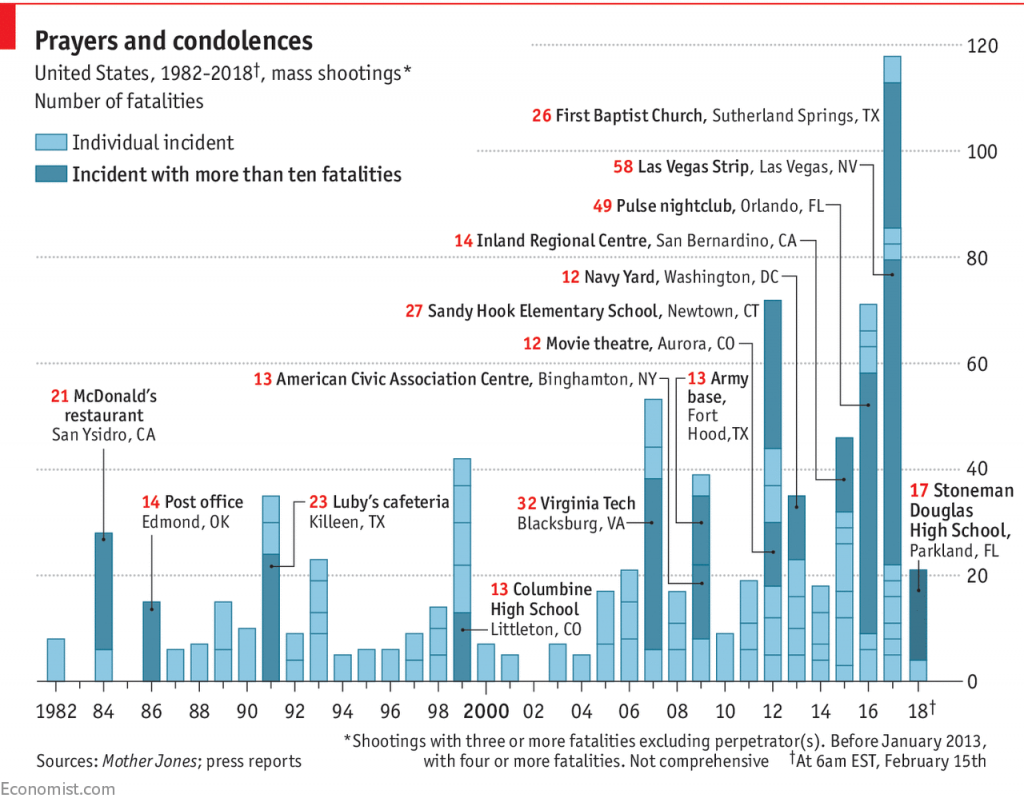
But if the U.S. tried to reinstate the Assault Weapons Ban, politicians would be confronted with scenarios like this in the Kentucky legislature in 2020:
When President Obama discussed reimposing the the assault weapons ban, CIA whistleblower Edward Snowden said “Me and all my lunatic, gun-toting, NRA compatriots would be on the steps of Congress before the C-Span feed finished.” Texas even has a fast-track for permitted handgun owners to bypass its capitol’s metal detectors. The traditional duty-to-retreat/castle doctrine combination of gun rights has given way in ~ half of the states to stand-your-ground doctrine that legalizes quasi-vigilante justice (including deadly force) for armed citizens who, by their own accounts, witness or experience violent crimes or even theft (wording varies by state). It’s easy to envision scenarios where that might work, but acting as judge, jury, and executioner is a lot of responsibility for one person to assume in a split-second, especially one untrained in law and law enforcement. Kyle Rittenhouse’s case broadened the debate on vigilantism further yet to include the prospect of an armed citizenry supplementing law enforcement or the National Guard. This is what’s meant above by the idea that the First and Second Amendments appeared on a collision course in states without event restrictions for protests. The First Amendment right to assembly and free speech (peaceful protests) isn’t now unusually expansive, but the arming of protesters under an expansive 2A combined with the Section 230 loophole in the 1996 Telecommunications Act providing immunity to Internet providers and hosts for disinformation are a combustible mixture when combined with the right to assembly with no event restrictions.
The NRA promoted semi-automatic sport rifles as a way for citizens to raise arms “against a tyrannical government run amok.” The U.S. government does run amok from time to time due to incompetence, poor judgement, or inefficiency, but it has no motive to invade itself given that the military already has firm control of the U.S. and has far more advanced technology than the citizenry. Unlike the 1860s, when two large armies faced off in the Civil War, we just have one real military today. Whichever government that military backs has political control of the United States. It’s likely the official armed forces will continue to back whichever politicians come into power via the Constitution, as they have since 1789. If anyone really challenges that authority instead of just barking about it, the military would wrap their rear ends around their faces before they could find Bunker Hill on their GPS.
The Second Amendment originally bolstered state government militias against a potential national (standing) army, not private militias opposing all government and police. Unsurprisingly and for obvious reasons, the Constitution (Article III, Section 3) forbids as treasonous citizens levying war against the United States and armed private militias are technically illegal in every state, which adds to their motivation for existing in the first place. NRA president Wayne LaPierre thought that banning semi-automatic rifles or bump stocks, even for 18-21 year-olds, would lead the U.S. down the path to “socialism” and argued for better enforcement of existing laws. At five million members, the NRA represents a small percentage of hunters (~17 million) and gun owners (~ 1/3 of American adults) and most NRA members weren’t as radical or absolutist as LaPierre. Within living memory, the NRA advocated for people buying guns for hunting, self-protection, shooting, or collecting, not militias aimed at overthrowing the government or hunting prairie dogs, the rationale John Thune (R-SD) gave for AR-15s. Such sentiments don’t come cheap. Here’s where he ranked in lifetime campaign donations from the NRA through 2020: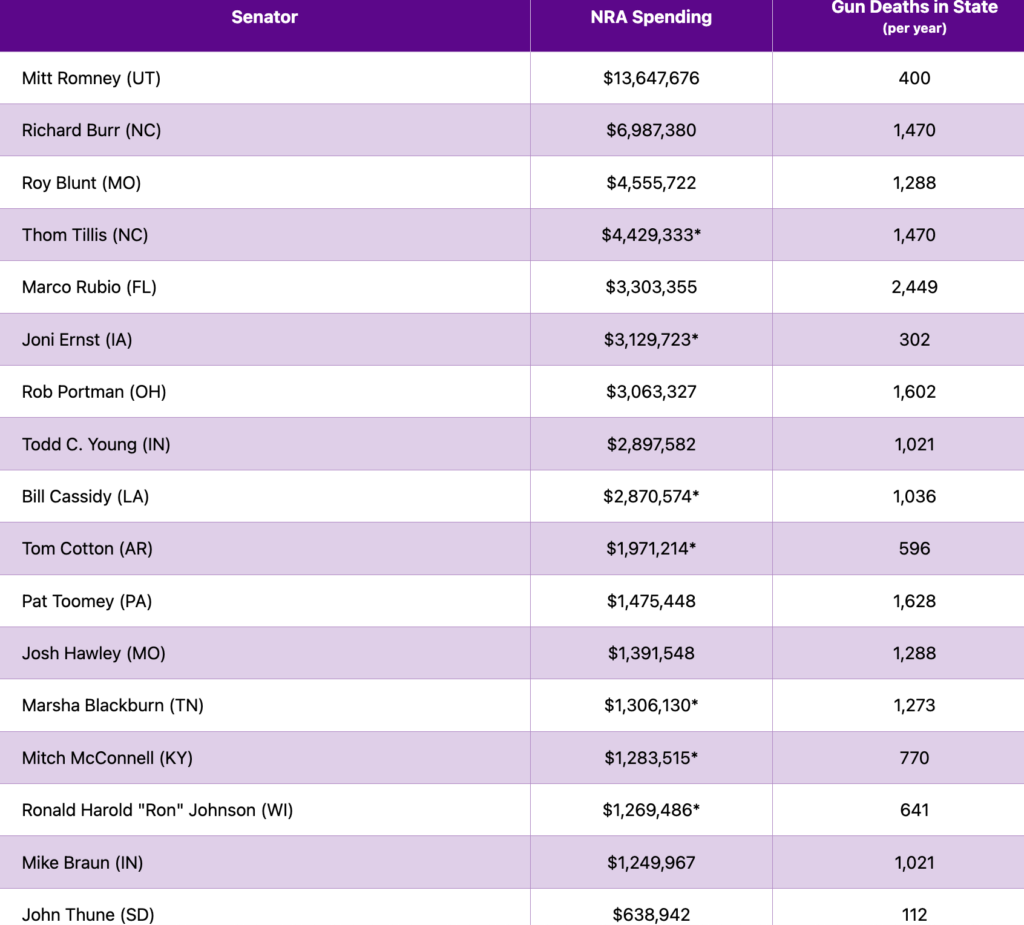
The idea that the Second Amendment forbids any gun regulation at all (2A absolutism) is new to American history, dating from the Smith & Wesson smart gun controversy of 2000, even though the national government didn’t regulate guns until 1934. Conservative Justice Antonin Scalia, a strong supporter of the Second Amendment, acknowledged in McDonald v. Chicago (2010) that the government can regulate guns under 2A. But McDonald and District of Columbia v. Heller (2008) also interpreted 2A as applying to individual gun rights, not just militias. Scalia was careful to point out that those individual rights are not absolute, but modern Americans view supporting 2A as meaning that anyone, including the mentally ill, should have easy access to near military-grade weapons. And SCOTUS, too, swung a long way to the right by 2022, arguing in New York State Rifle & Pistol, Assoc. vs. Bruen, in some opinions, for nullification of rules not already on the books in 1791 (2A), or at least 1868 (14A). Future rulings that expansive would nullify the forenamed 1934 Firearms Act and overturn the U.S. v. Miller (1939) case that has justified it Constitutionally. Up until now, few hunters, enthusiasts, or even the NRA have argued for overturning the 1934 Firearms Act.
W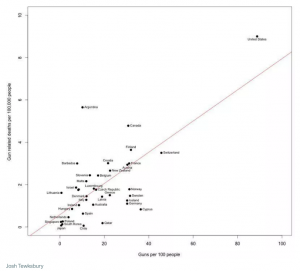 hile overall crime rates, including gun-related violence, fell between 2000 and 2020, killers used semi-automatic rifles as assault weapons in mass shootings in Aurora (2012), Newtown-Sandy Hook (2012), San Bernardino (2015), Orlando (2016), Dallas (2016), Las Vegas (2017), Sutherland Springs, Texas (2017), Parkland, Florida (2018), Santa Fe, Texas (2018), El Paso (2019), Dayton (2019), Midland-Odessa (2019), Boulder (2021), Buffalo (2022), Uvalde, Texas (2022), Highland Park/Chicago (2022), Colorado Springs (2022), and Nashville (2023). The cool thing about the gun industries’ business model is that every time someone misuses an assault rifle in a mass murder, sales of assault rifles go up. Bump kits allowed assassins like Stephen Paddock in Las Vegas to fire off 400-800 rounds per minute. The Buffalo killer wrote in his manifesto that the AR-15 and its variants are very deadly when used properly…which is why I picked one.” In Colorado Springs, a red flag law would’ve been imposed on Anderson Lee Aldrich before they shot up an LGBTQ nightclub, but El Paso County is a Second Amendment Sanctuary. Pro-gun advocates, including the NRA, often ask why we don’t just enforce existing laws rather than further regulate, but we can’t because NRA-funded candidates campaign promising to defy existing laws, including red flags and background checks.
hile overall crime rates, including gun-related violence, fell between 2000 and 2020, killers used semi-automatic rifles as assault weapons in mass shootings in Aurora (2012), Newtown-Sandy Hook (2012), San Bernardino (2015), Orlando (2016), Dallas (2016), Las Vegas (2017), Sutherland Springs, Texas (2017), Parkland, Florida (2018), Santa Fe, Texas (2018), El Paso (2019), Dayton (2019), Midland-Odessa (2019), Boulder (2021), Buffalo (2022), Uvalde, Texas (2022), Highland Park/Chicago (2022), Colorado Springs (2022), and Nashville (2023). The cool thing about the gun industries’ business model is that every time someone misuses an assault rifle in a mass murder, sales of assault rifles go up. Bump kits allowed assassins like Stephen Paddock in Las Vegas to fire off 400-800 rounds per minute. The Buffalo killer wrote in his manifesto that the AR-15 and its variants are very deadly when used properly…which is why I picked one.” In Colorado Springs, a red flag law would’ve been imposed on Anderson Lee Aldrich before they shot up an LGBTQ nightclub, but El Paso County is a Second Amendment Sanctuary. Pro-gun advocates, including the NRA, often ask why we don’t just enforce existing laws rather than further regulate, but we can’t because NRA-funded candidates campaign promising to defy existing laws, including red flags and background checks.
Ghost guns assembled from component parts also complicate the registration process because they lack serial numbers. Not all attacks were with semi-automatic rifles. In 2016, to oppose Trump’s election, a deranged leftist opened fire on Republicans practicing for their annual baseball game against Democrats, injuring the hip of Steve Scalise (R-LA). After Sandy Hook, initial polls showed over 95% of Americans and over 80% of NRA members supported expanding background checks, but the measure failed in Congress. After Parkland, Trump initially threw his support behind universal background checks, and purportedly asked aides why anyone needs an AR-15, but the NRA backed him down. The same scenario played out after El Paso. After each shooting, the GOP argued that it was inappropriate to discuss regulation so soon after a tragedy and that such regulations violated the Second Amendment and/or would be ineffective.
Americans remained divided on guns, with control advocates pointing out the ownership correlation to murder by country and state, while pro-gun lobbies stressed the need for more guns for protection amidst the mass shootings. Meanwhile, the death toll from domestic gun violence is far higher than other countries, killing more Americans in the first half of 2019, alone, than the country lost in the Normandy Invasion of 1944 and first month of combat against Germany. Suicide rates among white males are higher than other demographics and higher yet when the subject has access to guns. In 2015, Governor Greg Abbott admonished Texans in a Tweet® for not buying more guns, embarrassed that they’d fallen behind California for a #2 ranking. Over and against the wishes of police, Texas legalized permitless carry (aka constitutional carry) in 2021, allowing anyone, including convicts and those with a history of mental illness, to carry handguns with no permit, fingerprints, or firearms training required, or even knowing which end of the gun goes “bang.” If the respective sides of the debate shared anything, it was a common concern for safety; they just had opposing views on how to attain safety. This graph charted other points of agreement circa 2017, belying the amount of opposition portrayed in the media. After the Uvalde, Texas shootings in 2022, one congressman dismissed background checks by saying his voters used AR-15s to hunt prairie dogs. But, post-Uvalde, Congress and Joe Biden passed the Bipartisan Safer Communities Act (2022), which extended background checks for buyers under 21, and provided funds for state “red flag” laws and other crisis intervention programs for the mentally ill.
In “Guns & the Soul of America,” conservative columnist David Brooks interpreted guns as a proxy for larger issues in the culture war — as “identity markers” for freedom, self-reliance, toughness, responsibility, and controlling one’s own destiny in a post-industrial world. Vigilante Kyle Rittenhouse bought his because he “thought it looked cool.” Campaign TV ads in the reddest gerrymandered districts were an art form, testing who could be the gunniest while stopping short of actually putting their Democratic opponent in the cross-hair, as that would’ve risked future liability. But Democrats were in on the act, too. Jason Kander, a former captain in the Army National Guard and Missouri Secretary of State, explained his support for background checks on a campaign ad while assembling an AR-15 blindfolded, so that “terrorists don’t get their hands on these.” Brooks’ cultural currency and political symbolism seem to explain the popularity of semi-automatic rifles best, as they’re otherwise more than enough weapon for hunting or protection but not enough for revolution.
Optional Reading & Viewing
Ryan Goodman & Justin Hendrix, January 6th Clearinghouse (Just Security, ongoing)
Jonathan Haidt, “Why the Last Ten Years of American Life Have Been Uniquely Stupid” (Atlantic, 4.11.22)
Megan Garber, “We’re Already In The Metaverse” (Atlantic, 3.23)
Is Cancel Culture Toxic? Intelligence Squared Debate (11.21)
Hugh Breakey, “Is Cancel Culture Silencing Opening Debate?” (The Conversation, 7.20)
Tadeg Quillien, “Is Virtue Signalling a Vice?” (Aeon, 4.22)
Nicholas Riccardi, “Slow-Motion Insurrection: How GOP Seizes Election Power” (AP, 12.30.21)
Heather Hollingsworth, “Teachers at Culture Wars Front Lines with January 6 Education” (AP, 1.4.22)
George Packer, “Imagine the Worst” (Atlantic, 1-2.22)
Barton Gellman, “January 6 Was Practice” (Atlantic, 1-2.22)
Jeffrey Goldberg, “The Patriot: How General Mark Milley Protected the Constitution From Donald Trump” (Atlantic, 12.23)
Barton Swaim, “The Impossible Insurrection of January 6th” (Wall Street Journal, 11.19.21) ACC ID Required
Paul Solotaroff, “He Spent 25 Years Infiltrating Nazis, the Klan, and Biker Gangs” (Rolling Stone, 1.30.22)
Thomas Chatterton Williams, “The French Are In A Panic Over Le Wokisme“ (Atlantic, 2.23)
Staff, “AR-15 Manufacturers Marketed The Guns As Tools For Mass Murder; That Was The Whole Appeal” (Daily Kos, 3.28.23)
Geoff Schullenberger, “The Poverty of Anti-Wokeness” (Compact, 12.29.23)



